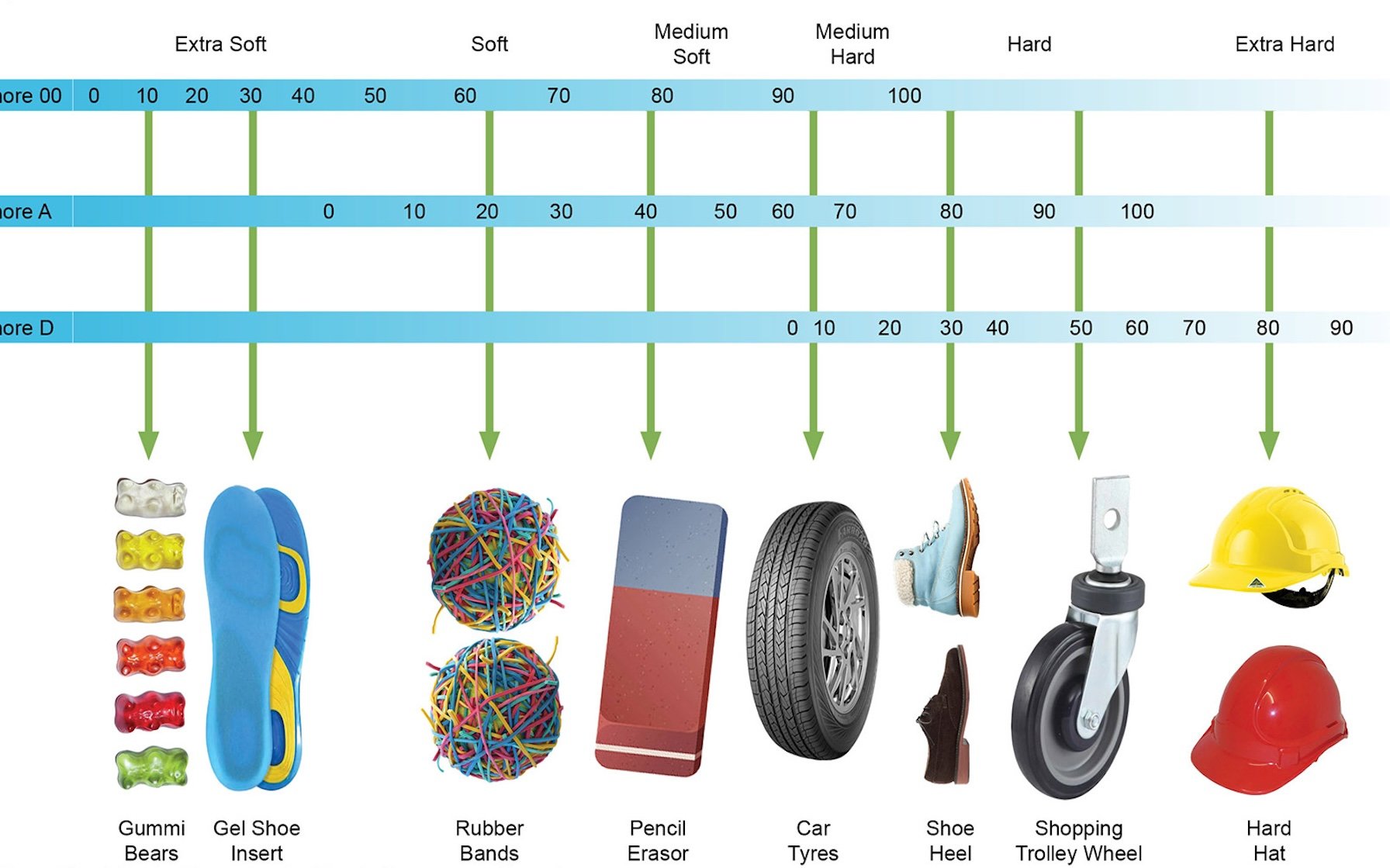
Beggars Would Ride
A Shore Thing
Sometime back in the 1990s, probably about the time that elastomer suspension was a thing, I learned about the Shore durometer scale. At a time when journalists would get frothed over the possible differences between open cell and closed cell foam, Shore durometer helped define one of the behavioral parameters of rubber in a way that allowed those frothing journalists to pretend to understand what was going on. Sometime after that, probably about when 5.10 Stealth rubber showed up on Intense tires, Shore durometer entered the discussion with regard to tire performance.
The Shore durometer scale, named after the measuring device developed in the 1920s by Albert Ferdinand Shore, is actually 12 different scales; A, B, C, D, DO, E, M, O, OO, OOO, OOO-S, and R. Each scale has a value range between 0 and 100, with 0 being the softest expression of that scale and 100 being the hardest. If we are talking about, say, bicycle tires, we’d be in Shore scale A. If we were measuring the hardness of chewing gum, we’d be using Shore scale 00.
Sticking with Shore scale A, and staying in our lane regarding bicycle tires, the method of measurement involves steadily pressing a hardened steel rod between 1.1 and 1.4mm in diameter – with a truncated 35 degree cone and a tip diameter of .79mm – into the material being tested with a force of 8.064 N for a duration of 15 seconds. The amount of measured deformation gives us our final Shore A rating. If the indenting tool presses 2.54mm or more into the material being tested, the durometer for that material would be 0. If it does not deform the material at all, the durometer would be 100. For reference, car tires often rate out around 70A, hard skateboard wheels would be 98A, rubber bands might measure around 25A, and the Specialized Purgatory T7 I reviewed last week has a 50A durometer.

Pointy thing, load, deformation: Shore durometer test.
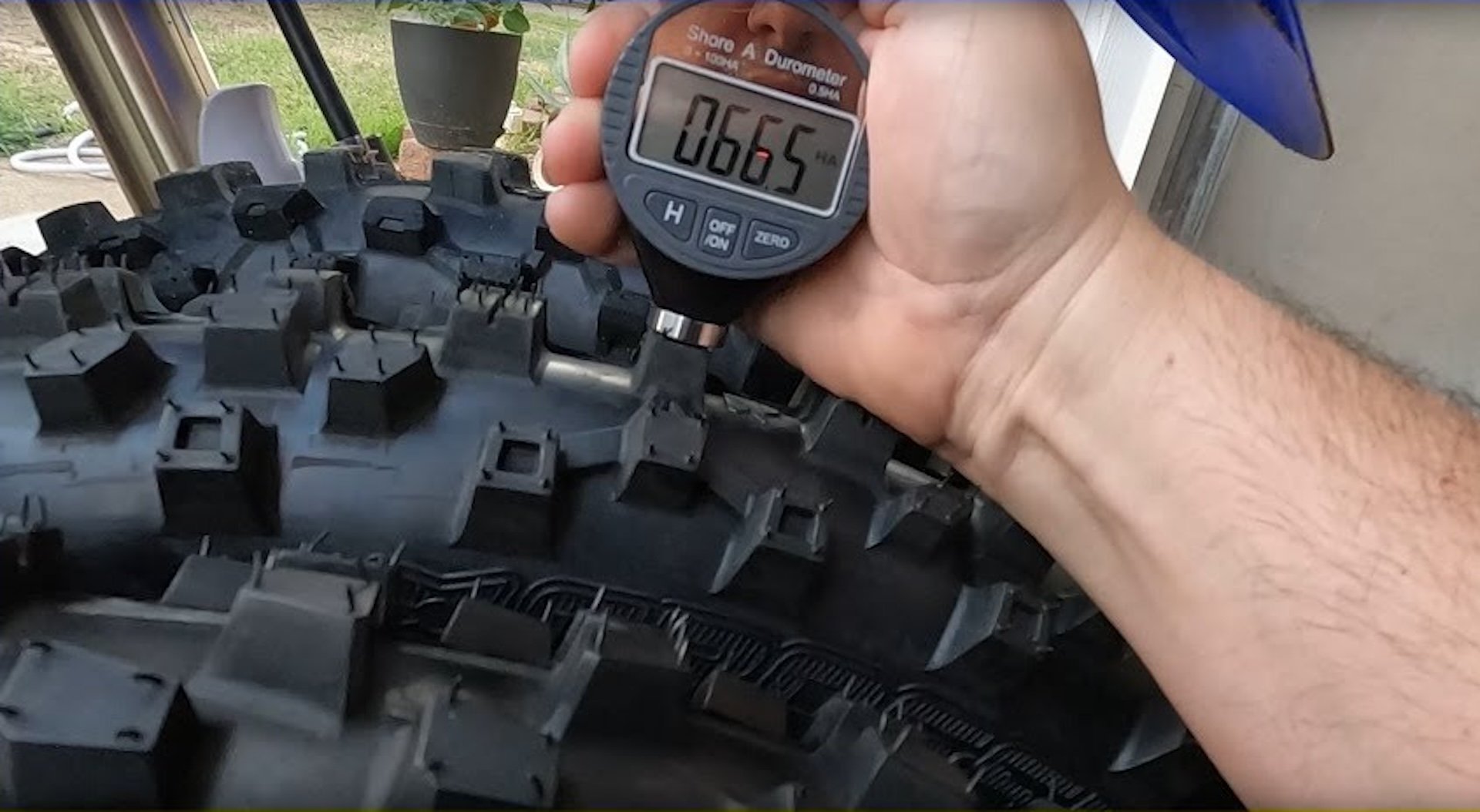
In action, this is what a digital Shore durometer looks like. You probably all already know this, and I am willing to bet that some of you own one of these. I don't. Yet.
When I was riding this tire, I was thinking about the differences in ride characteristic between T7 rubber and T9 rubber, and assumed that the T7 compound was a harder durometer than the T9 compound. Because, according to Specialized, T7 is a more durable and faster rolling compound. Thus my assumption. This is the point in the narrative where the booming voice of Frank Campbell, my high school woodworking teacher, interrupts; “Now, Ferrentino, you know what happens when we assume things, don’t you? You make an ASS out of U and Me!”
My assumption has always been that stickier tires will have a lower Shore A number than high wear tires, that softer rubber is how tires derive traction and ride characteristic. So it was a bit of a shock to find out in an email exchange with Matthew Bialick at Specialized that both T7 and T9 compounds share the same Shore 50A durometer. Well, shit. Frank Campbell can be heard laughing heartily in the background.
As it turns out, hardness is only one component of the grip equation. Compound matters too. So, with regard to the difference between Specialized’s T7 and T9 compounds, the 50A hardness, according to Matthew, “is the ideal balance between ground adaptation and rider support.” But, “for us, it’s hard to talk about compound hardness and not discuss the damping characteristics as well. Comparing tire compounds between multiple manufacturers isn’t straight apples to apples, especially with different compound layouts, mono versus stacked multi-compounds, et cetera.”
Matthew continued; “What makes mountain compounds special is tuning the damping of the compound. For grip, it’s about damping the vibrations from the trail as the tire rolls over it, essentially quieting the ground in turn giving you a constant connection for grip and control. Durometer still very important but only one piece of the formula.”
Two compounds. One feels more grippy, but what I am feeling is really the sensation of a tire being less reactive, more damped. The other rolls faster, wears better and is more “lively.” Same durometer. Huh.
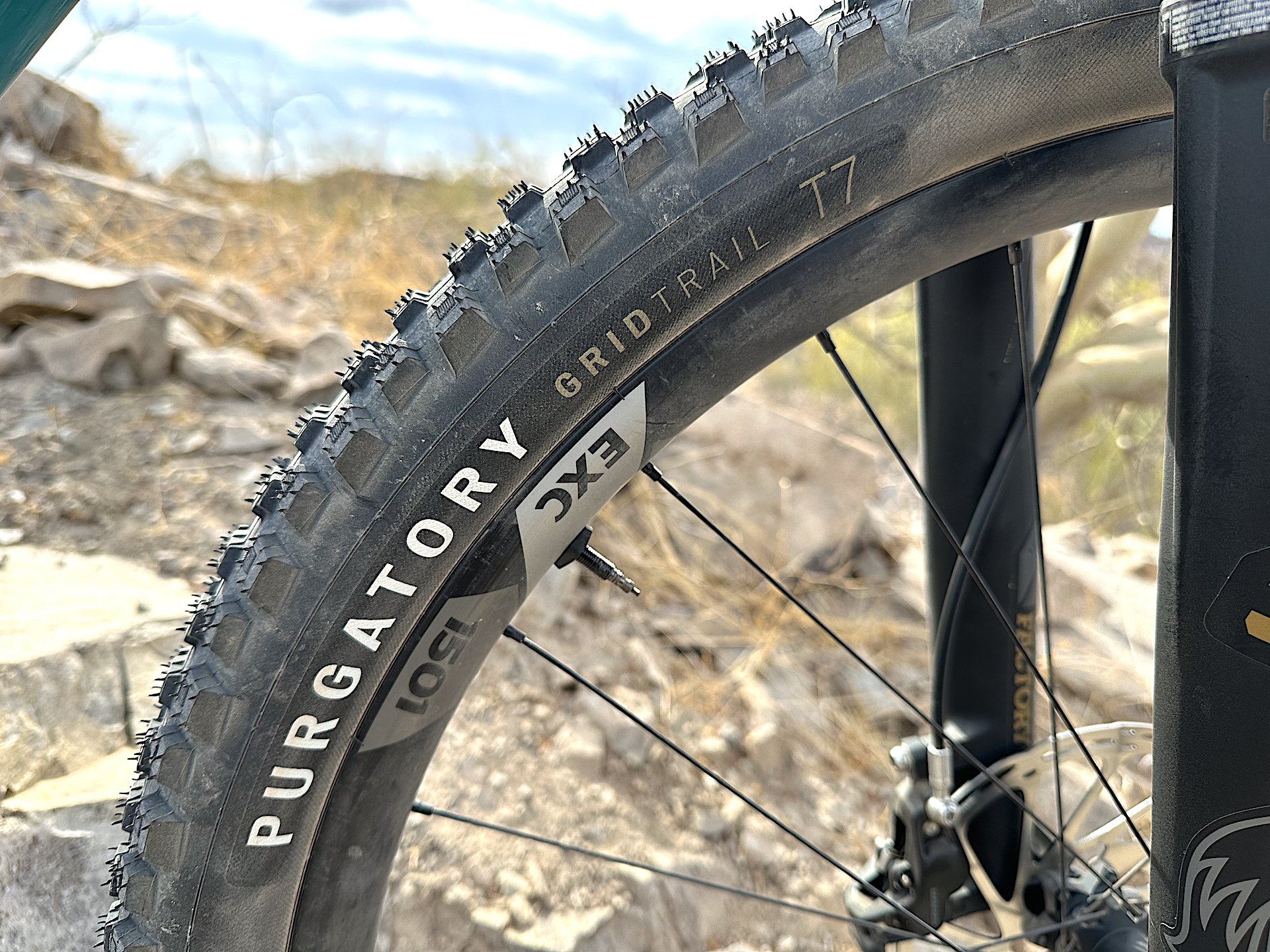
The tire that got me thinking about all this...
Naturally, this led me to bring up a whole barrage of other questions. How do you change the damping behavior of a tire with compound, if the durometer of the tire remains the same? Does the harder wearing tire have more carbon black, and does that make it a less damped tire? Or is there more silicone or urethane on the more bouncy, less damped tire? Given that each compound is essentially the same durometer, is the knob shearing potential the same, or does the difference in damping also imply a difference in wear rates and lifespan? And if so, how is that achieved?
Meanwhile, thinking about how durometer does not matter in as central a way as I thought it did, I ended up also wondering about hysteresis. Hysteresis matters in tires, a lot. But, as with hardness, it turns out what I thought hysteresis was is completely erroneous. Shit, I’ve even been mispronouncing the damn word my whole life. It’s pronounced hiss-tur-eee-sis. I always thought it was hiss-tair-uh-sis. No wonder tire compounders always shake their heads and chuckle amongst themselves when I’m asking them questions. Aaaanyway, I always thought that hysteresis was a measure of how bouncy a rubber compound is. And, in a way, that’s true, but not the way I thought. According to Merriam-Webster, hysteresis is “the slowing of an effect when the forces acting upon a body are changed.”
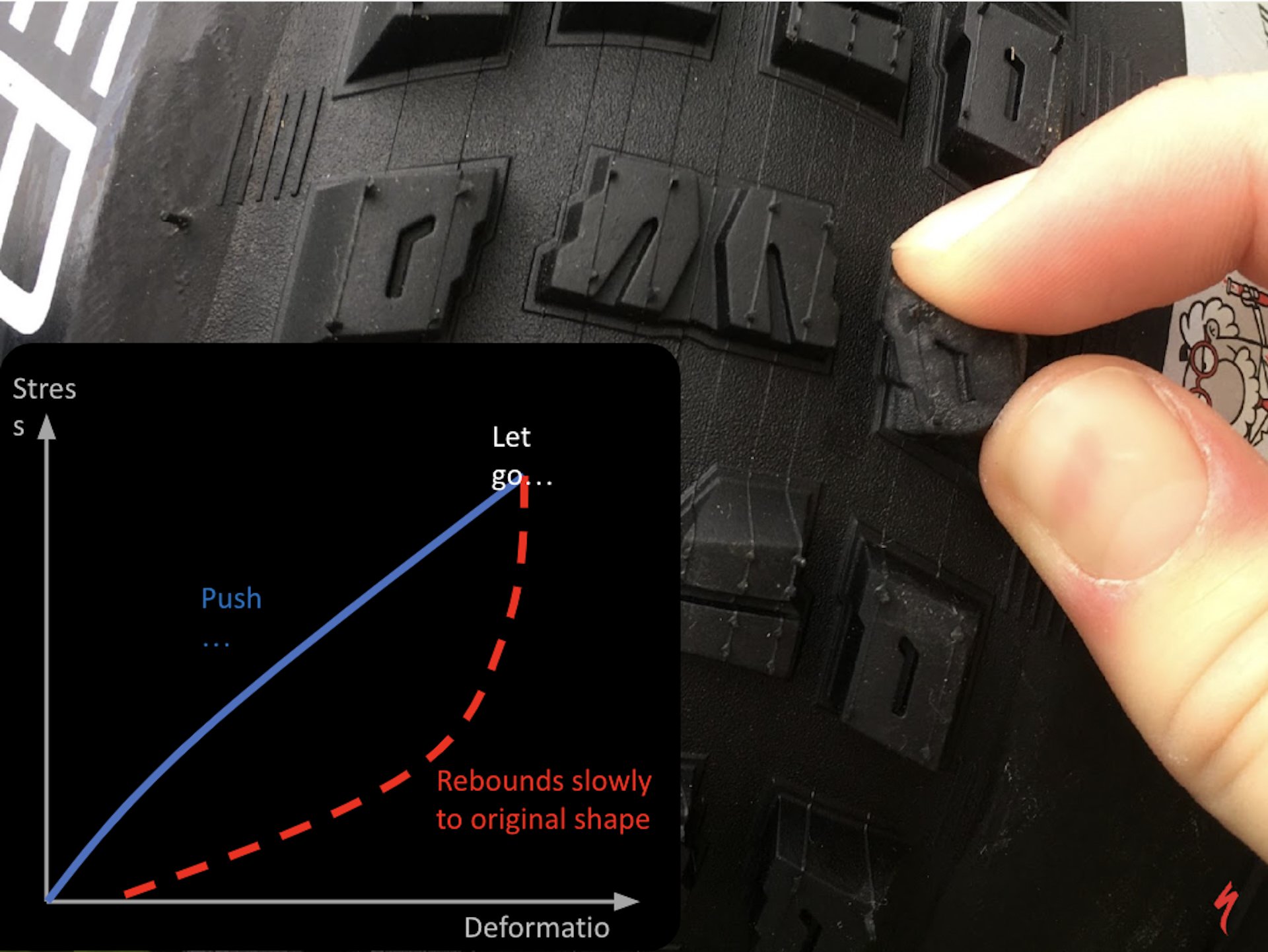
So, the difference between compression (in the case of a tire squishing into terrain) and rebound (the speed at which the tire regains its shape) is hysteresis. This is where energy gets turned into heat. The more hysteresis, the more damped a tire may feel, and the more tractable. But it'll also feel slower.
In the case of rubber, that change is best described as deformation getting converted to heat. The forces being fed into a tire as it deforms over a surface are not immediately responded to equally. There is a lag, and some of that energy gets absorbed and converted into heat, and then the tire returns to shape somewhere near what it was before. This is damping – energy being absorbed and converted. And this is why elastomers were considered good candidates for suspension way back when. Unlike metal springs, rubber has a pronounced hysteresis that does not return all its energy when released from compression. This is also a huge factor in how a tire generates traction, or friction. Hysteresis is a major component of rolling resistance, because it is dissipating energy as heat instead of returning it.
So, with Specialized tire compounds, the durometer difference between super tacky, highly damped T9 rubber and ultra fast rolling T2 rubber is negligible. T2 is about 51A and T9 was somewhere around 45A, when I was watching Wolf VormWalde, Specialized's tire research wizard conducting a Shore test during a Zoom call. The T2 rubber rolls fast because it has a much lower hysteresis - the amount of energy that gets transformed into heat between loading/deformation and unloading/rebounding than T9, in spite of being almost the same durometer. And it has a much lower hysteresis because different polymers are used in each tire.
There are up to 15 different polymers, oils and fillers in a given Specialized rubber compound. The rubbers can be defined as natural and synthetic, and there is a whole pile of varying viscous polymers in the latter range that are called Styrene-Butadienes. The more styrene in one of these, the more plastic and less viscous it will be. The more butadiene, the more squishy it will be. Then, the fillers get added in. Carbon black does not adhere to the polymer chains in a given compound, and therefore allows that compound to flex more freely in all directions. Silica does adhere to the polymer chains, and that in turn helps bind them together and limits how much they can squirm around. More Silica in a compound then means that a tire will be more bouncy, faster rolling, more resistant to shear and tear forces, and probably more durable. More carbon black and the tire will be more damped, more tractable, but slower rolling and less resistant to tear and shear forces.
T9 tires use a whole lot of carbon black as filler and no silica. T7 and lower only use carbon black for color, and then rely on silica and other fillers. This, along with the particular ratio of Styrene-Butadiene being used in the compound, is why T9 will result in a grippier tire than the others.
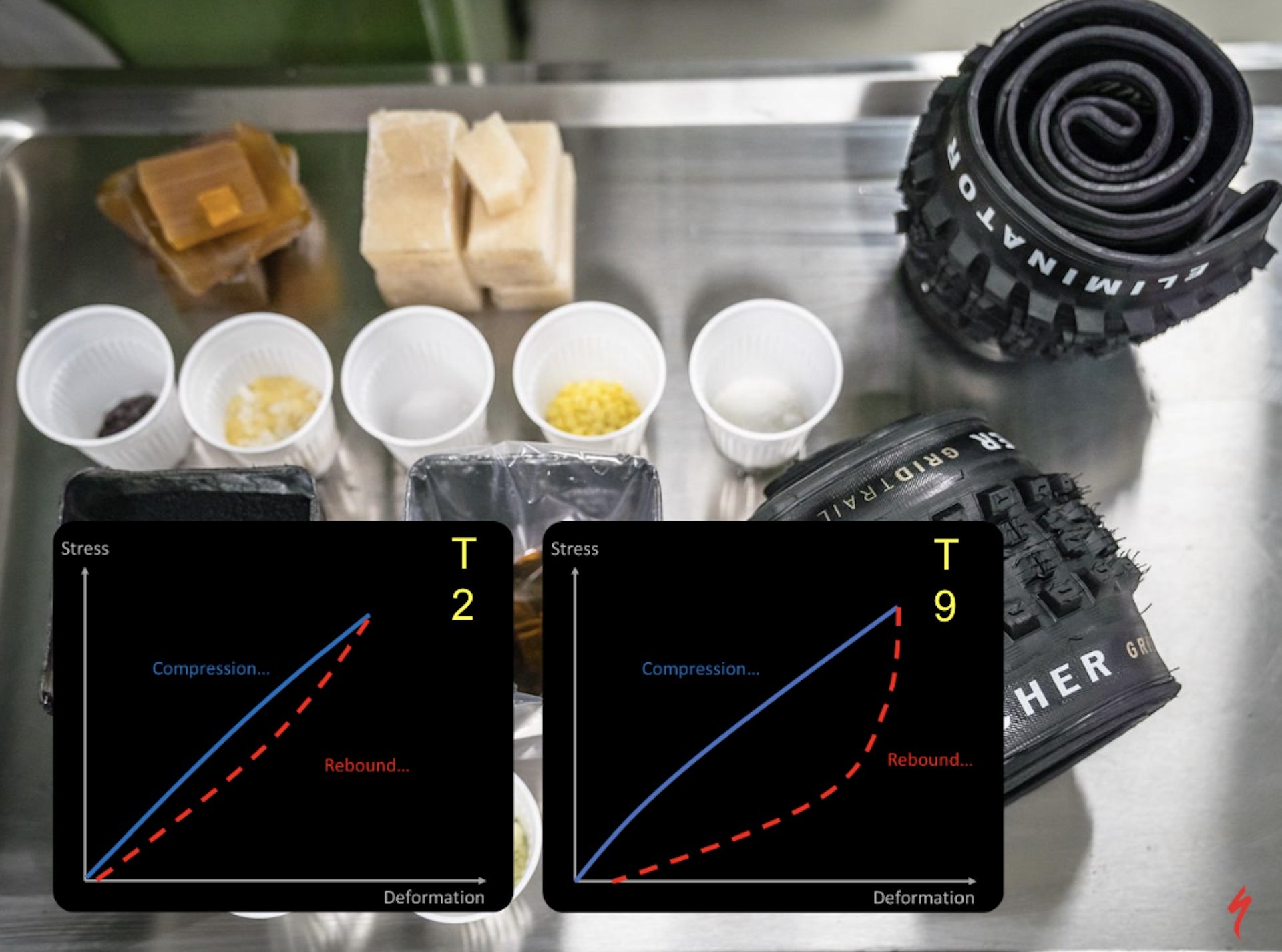
Horses for courses, they say. Road tires need to be fast and efficient. DH tires need to be highly damped. The compounding challenge lies in trying to find out how to combine each of these desired traits in search of that mythical unicorn tire that grips like crazy but still rolls fast.
All of this – durometer, compounding, hysteresis – is in play when you are ripping down the trail. Those slow pedaling Assegais? It’s not necessarily just weight that makes them feel that way. Hysteresis, how much of your energy that tire is absorbing while at the same time increasing the traction you reflexively depend upon, is making itself felt. This is a head explody design paradox. Traction is king, but increasing traction is almost always going to also increase rolling resistance. The people who design our tires are using compounding, durometer, tread patterns and casings to try and thread the needle between traction and efficiency, in the hopes of gaming physics and delivering tires that offer the traction you need without sacrificing all your pedaling efficiency.
As I was climbing up a section of grippy sandstone slabs yesterday, I could feel my rear tire squirming for bite. I imagined each of the knobs deforming and reforming, all these tiny actions and reactions, energy being converted to heat and resulting in adhesion, tiny slivers of watts being lost but at the same time forward motion being maintained. Instead of reducing assessment of my tire’s performance to the binary of “awesome” or “sucky”, I quietly thanked my tires for doing their incredibly demanding job.
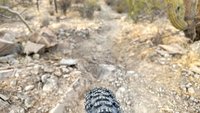

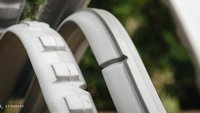








Comments
Moritz Haager
2 weeks, 3 days ago
Very cool article. I really learned something. Thank you.
Reply
jddallager
2 weeks, 2 days ago
Totally agree. I never get "TIRED" of learning about Shore, hysteresis, and shock/fork ..... oooops, make that tire ...... rebound.
Next, some readers will likely tell me I need to get a grip! OUCH! :-)
Reply
Deniz Merdano
2 weeks, 3 days ago
Every now and then I can feel the individual knobs of my front tire deform and flex and grip and slide on the complex ground they are rolling on. I can feel the little suction cups of the tentacles reaching for the little pine cones and tossing them aside for me to hurl the carbon, metal, flesh combination that I am down the hill. Then I realize I am far from Barstow but the 500mg Psilocybin is doing it job nicely...
Reply
Pete Roggeman
2 weeks, 2 days ago
Halfway through this comment I was going to make a LSD/Psilocybin comment but you were already headed there!
Reply
XXX_er
2 weeks, 2 days ago
all the right people are microdosing nowdays
Reply
Kyle Dixon
1 week, 6 days ago
Some of us are even getting the gov't to pay for it...
Reply
Dave Smith
2 weeks, 3 days ago
This is good beta coming hot on the heels of debate I had on Shore worthy tires this week.
After a winter of riding my rear wheel was haggard so I stuck on a Maxxis Minion DHR 3C DD Maxx Terra. With it being early season and few options in the local shop I put on the Maxx Terror that I usually wouldn't run until the blown out days of Summer. Skeptical but with few options, I pumped it 25psi and five minutes into my next ride I can confirm that it was Maxx-Terrifying in the current tweener-season of wet rock and greasy AF roots. Following a few near death experiences, I peeled the tire off a few days later and replaced it with the proven Maxxis Minion DHR 3C DD _Maxx Grip - Simply swapping compounds the experience was It was night and day.On the same trail and in similar conditions, I instantly felt improved performance and predictability. In my mind, it's worth burning through the cost of an extra tire or 2 per season to get confidence back on the steep and slick green stuff.
Reply
XXX_er
2 weeks, 3 days ago
THIS ^^ I mtn bike for fun not to save money so I just pay the money and I don't worry about trying to find a better tires than the Assguy/ minion combo, also the whole exercise of searching for the holy grail of tires would eat up a bunch of $$$
Reply
Perry Schebel
1 week, 6 days ago
that said, coming off a maxxgrip shorty rear (i buy whatever mg's are cheap for rear winter use) the MT DHR i just mounted feels like an xc semi slick in terms of rolling resistance. we're done with rain for the season, yeah?
Reply
Mark
2 weeks, 3 days ago
If this info was in a marketing brochure I might be inclined to say to myself this all sounds like a bunch of bafflegab to justify the high price of tires. But it's not and it makes a lot of sense. However, if the next edition of Pistons and Pivots has Mike alongside an Ursus or Bentayaga we'll know what's up. ;)
Either way, I still think tires are too expensive. Maybe it's time NSMB did a blind tire test based on MSRP with some premium tires and some not so premium tires to see just how big a difference there really is between a $50 tire and a $150 tire.
Reply
Allen Lloyd
2 weeks, 3 days ago
We started buying Specilized tires because they are cheaper, have noticed little difference 90% of the time. The other 10% is noticeable when really pushing in difficult conditions. That said I have a set of Schwables that are like voodoo magic in soft slippery conditions and I am convinced their sidewalls have insights from Satan to be able to take a cut and not go all the way through.
Reply
fartymarty
2 weeks, 2 days ago
There's something special happening with my Magic Mary Ultra Soft Super Gravity. I feel like I'm cheating when I ride it as it sticks like nothing I've tried.
Reply
BarryW
2 weeks, 1 day ago
I recently put a Magic Mary in Soft on my front, replacing the harder Hans Dampf and it's been a revelation for how much more grip there is.
Gonna try Ultra Soft for the next one I think. I wanted to go that way but in my preferred 2.6 size it just wasn't available in anything but DH casing. Maybe I should skip the front insert and go that way.
Reply
Pete Roggeman
2 weeks, 3 days ago
Love this idea in principle, but:
1) How do you propose blind testing a tire? It's impossible to conceal a tread from a tester's eyes, and
2) How many tires with a legit tread and a SRP of $50 can you name? Plenty of legitimate $80-100 options out there but not many our collective group has used and found can hold up to the demands of the Shore when it's wet.
It might be more informative for everyone to get a glimpse at how much R&D goes into a tire's development, and then the manufacturing and material costs. Not to mention shipping. Of course everyone likes to compare a $150 MTB tire to a car tire's price, but that car tire is always a shitty all-season that's no better than a take-off tire, whereas that $150 MTB tire is pointy edge of the tech wedge for our sport. I'm not saying they couldn't/shouldn't be less than 150 retail, however there are so few legitimate contenders out there that deliver a consistent product that performs and is available, that it's hard to expect otherwise until that changes.
Reply
Mark
2 weeks, 3 days ago
@Pete Yeah it's very difficult to conceal a tire. At least side-walls could be spray painted black to hide manufacturers names, etc, but the tread design would still be noticeable, so there would need to be some integrity on the part of the testers to not look at the tire while stopped to try and figure out what they are riding. Maybe some sort of starting gate where the tired is concealed from view and testers don't look at the tire at the bottom of the run could work.
Re numbers, I just picked two out of the air. The $150 is of course reasonable for top shelf tire, at the $50 end I have no idea, maybe $75 is a better marker? The idea is simply to get a sense of how much extra performance you're getting for spending an extra $50-75 per tire.
In terms of contenders there's obviously Maxxis, Schwalbe and Continental at the pricey end and Specialized and Michelin somewhat close. At the other end maybe Onza, Vittoria and Vee Rubber?
The idea is not so much to find the best performing tire but which tire provides pretty good performance for a much lower price. Say can you get 80-90% of the performance for 40-60% of the price? Another thing I'd be curious about is if a brand new budget tire can outperform a worn high end tire. So maybe over their lifespan two budget tires will yield similar to better performance for more km's vs a high priced tire.
Reply
Pete Roggeman
2 weeks, 2 days ago
The start gate idea is pretty good!
Of course there's a big difference btwn 200 and 300 bucks for fresh rubber front and back but if it was necessary that extra 100 is better spent on rubber than anything else.
Reply
Mark
2 weeks, 2 days ago
@Pete
I've ridden primo tires and not so primo tires on enough sketchy stuff to know that for sure there is a difference between the two and that sometimes that extra $100 is well worth the price of admission. Call it cheap insurance. Tires are the one place where an extra $100 can have a huge positive impact on the ride - Dave's near death story below is a good example. The comparison suggestion is borne out of curiosity more than anything else and I think it would provide for not only good reading but lively discussion as well.
Part of my impetus in asking these sorts of questions is that I am naturally curious, plus I am fortunate enough to have multiple bikes for different riding styles so not every bike needs top line tires. I get that for someone doing a one bike program it seems silly to dither over $100 for better traction on a multi-thousand dollar bike. But that there are a fair number of people who don't necessarily need primo tires on their bike for the type of riding they do. So I can see there is definitely some ground where the cheaper alternative not only provides enough traction but better longevity, which makes it an even better buy.
Reply
Lynx .
2 weeks, 1 day ago
Mark, I'm with you on this, not all of them need super expensive/fancy super grip tyres. Also, not everyone has the luck to live on the north shore or have those sorts of trails available to them all the time. Also, lots live where it's a lot more open and trails are more dry most of the year or more rock filed and so a tyre that last longer and/or for cheaper in those conditions might be the ticket.
Personally, I'm now trying to find something that isn't a DHR2, Assegai which just offers a crap load of grip which can make up for shit technique, trying to find something more to the XC/Trail side of things and work on my technique to get/find grip/traction and cornering speed - I watch the XC Pros on what to most are essentially slicks find grip on insane terrain, wet or dry and wonder.
BarryW
2 weeks, 1 day ago
That's actually a pretty good concept for that kind of test.
Reply
psuedoScience
2 weeks, 2 days ago
re 1) blind testing:
A blind, or double blind test is not the only way to run a test and gather some sort of inference. Although it is popular in some fields, i.e. medicine, it is one of many experimental designs.
A factorial design with replication might be more appropriate than a blind study, but it may suit those looking to determine which tire setup (and other factors) produces the lowest time to complete a section of trail rather than specific tire qualities.
Any Industrial Engineer or Statistician should be able to design an experiment for you.
A deeper read for those interested:
https://www.afit.edu/stat/statcoe_files/Classical%20Designs-Full%20Factorial%20Designs_Final.pdf
Reply
Mark
1 week, 6 days ago
Yeah, I made the somewhat blind suggestion knowing how bias and preconceptions could affect someone's actual perceptions/thoughts on how the tire performed. Timing could be used to see if a primo or budget tire is faster, but when the trail surface is highly variable, along with other factors, statistically relevant different times can be achieved by the same ride on the same bike/tires.
My feeling is that this sort of test would be mostly qualitative in nature, but with some quantitative data included as well - so mixed method. I like your idea and agree it would likely provide more accurate results, but I think it would be a challenge to get enough people and tires to run a test like you suggest. Maybe a more simplistic test would be good just to see if there's any credence to the idea that budget or lower priced tires can do a good job, and if the data is positive then maybe a lesser known tire co. might pony up the dosh to run something more complex.
NSMB - nerd shore mountain biking
Reply
Mike Ferrentino
2 weeks, 3 days ago
Tire price is something I steered clear of in this, because, well, I just did. Something to consider though: MOST tire brands are having their tires manufactured by one of a handful of tire factories. Those factories will take the tread design that the tire brand wants implemented, and offer the brand a choice of several different compounds. The tire brand does not get to decide the formulation of those compounds. Unless the brand is Continental, Michelin, Specialized, Maxxis (Cheng Shin), and maybe a couple others. And even then, many of these brands will use a basic off the rack formula for their budget tires. Compounding is a very secretive affair, and tire companies guard their formulation and their inventory very closely. This, along with production quantities, and relative sophistication of casing manufacture, is part of why bicycle tires are likely to cost as much as some car and motorcycle tires. They are more painstakingly designed, and then produced in much lower quantity with more precision than the off the rack car tire produced in the millions.
Reply
Mark
2 weeks, 1 day ago
Those are fair points and I've always recognized economies of scale when it comes to all things mtb. However, I've always wondered what the actual cost to manufacture and import a tire is and how much mark-up we are paying. My suspicion is that some mtb companies are making a lot of green via exorbitantly high mark-up, and that includes tires. In terms of the manufacturing of a high end tire vs a department store bike tire and I have hard time reconciling that there is an extra 800-1000% cost in the creation of that high end tire.
Reply
rojo
2 weeks ago
Bike shops going out of business all over the place would suggest that there isn't loads of cash sloshing around
Reply
Mark
2 weeks ago
True, but bikes shops are not manufacturers. In relation to the story, what's the financial health of Maxxis or Schwalbe?
Reply
rojo
2 weeks ago
A quick bing would suggest they are making plenty, but that's our fault... If we insist on running Assegai/DHR2 then there is no surprise that they're going to rip us off. If we go looking for products just as good at a lower price point, then they'll have to price match. The onus is on us to be savvy shoppers rather than the brands to slash prices as some sort of charitable act to MTBers.
Mark
2 weeks ago
@rojo
Yes, which is exactly why I made my suggestion of doing a blind tire test between the top tier tires and more budget friendly tires. I think if people knew there were reasonable options available for significantly less money they would be willing to try them out.
Re - brands slashing prices as a charitable act to mtb'ers, my personal philosophy is that companies should follow good ethics of fair wages and fair profits and supporting the communities they sell to. I'm not anti-capitalist, but I'm also not a capitalist bro either.
Here's a question - how much does Maxxis, Schwalbe or any other tire company (any mtb manufacturer really) give back to the mtb community in terms of supporting trail advocacy and maintenance? How much should they give back - is 10% of their profits too much? I feel it's quite reasonable that a company making money off the backs of what is primarily a volunteer labour force should be giving back AT LEAST 10% of their profits. I'd also dare to say that people who do documented trail/advocacy work on public networks (sanctioned trails) should not be paying for consumables like tires, drivetrain, grips, etc based on the number of hours they put in.
I don't trail build to score free gear, but the fact that MTB companies are profiting off of free labour doesn't sit well with me.
Devin Zoller
2 weeks, 3 days ago
So good, thanks Mike. I was just yesterday trying to describe to my wife why I was swapping tires AGAIN and flailing around with words like “bouncy,” “sketchy,” “nervous,” and “fast!”
Turns out my preferred combo of Magic Mary ultra soft front and Big Betty soft rear gives the right amount of grip and calming, to the point that I’m actually faster because I can just ignore the tires and trust the bike. Whereas the Knobby Nick and Special Laughter combo is lighter, faster rolling and significantly slower downhill because it’s bouncy and I can’t trust the grip even on trails where I’d theoretically want those tread patterns more than the other ones.
And now I know why!
Reply
Mark
2 weeks, 3 days ago
@Devin that trust thing you talk about is a HUGE factor in getting better/faster on the bike.
Reply
Pete Roggeman
2 weeks, 3 days ago
There's something magical about getting the your tires dialed, isn't there? Tread, pressure, compound, etc., when it all comes together, it's so damn good.
Reply
JVP
2 weeks, 3 days ago
100% this. I'll take great tires and mediocre bike ever single time over a great bike with mediocre tires.
Reply
rojo
2 weeks, 1 day ago
Completely agree. There is no such thing as expensive tyres because market forces determined that someone extracted that amount of value from them. Also, budget tyres will always be available, so the question is really whether someone should be spending a lot on their tyres.
I would argue that if they can afford it they should. Comparison with car tyres is bizzre due to production volumes. What we do on bikes is more akin to Motorsport than driving to the shops...
If we were willing to spend more on tyres then there would be more competition and R&D and better tyres would be developed.
I have spent a lot of time this year doing accurate timed tyre testing of multiple premium brands. It has probably cost me around £750 so far, but my bike is 1.5% quicker (if I get chance later this year I will publish the test results).
A friend bought a new Enduro bike to compare to his 5 year old one, cost many £thousands and we spent a day doing accurate timing: it was 0.8% quicker.
Reply
BarryW
2 weeks, 1 day ago
Recently put a Magic Mary in soft on my front and it's given me so much more confidence to rail corners than before.
As you say, magical.
Reply
Andy Eunson
2 weeks, 3 days ago
Tires are expensive and good grippy tires are worth every penny. If I crash because I have shitty cheap tires, the physiotherapy costs will exceed the cost savings of cheap tires.
Grip and tire compounds are super complex. We consumers need to have a certain amount of trust and faith in the marketing. Understanding which combinations of durometer, tread pattern, casing stiffness or compliance, amount of pressure is beyond many of us to fully understand. Riders are reluctant for good reason to try a new brand or model of an expensive tire when they have been using something that has been working well for them for years, like Maxxis DHF, DHRII.
Reply
Kos
2 weeks, 3 days ago
Perfect, long read for the upcoming AZ road trip that starts in 24 hours. Thanks, Mike!
Reply
JVP
2 weeks, 3 days ago
Really informative! I'm a total tire nerd, but never understood this stuff. Thanks for writing this up in this way.
Reply
itsky21
2 weeks, 3 days ago
I came here this morning to read something like this. Good stuff, I learned a lot here.
Reply
XXX_er
2 weeks, 3 days ago
tires are too expensive and so are the mtn bikes they are mounted on, so if there were more people riding more mtn bikes and I mean millions and millions , it would all became cheaper
then we could complain there were too many mtn bikes
Reply
itsky21
2 weeks, 3 days ago
I would love to read more on tire deep-dives to expand on this type of knowledge and learning of tire/wheel impacts. For example:
Reply
Cooper Quinn
2 weeks, 2 days ago
"best" is impossible, because the criteria for what's the optimal balance of every factor will be different for every rider.
Two physically identical riders in the same terrain on the same bike may very likely decide two different tires are "best", because of different desired characteristics.
That's not to say there's no value in trying some of these things; what we as testers are here to do is try things, and then articulate who the customer for any given product may be. But there is no universal best, especially given the breadth of what mountain biking encompasses globally.
Reply
Mike McArthur
2 weeks ago
If a 50A tire made 3 years ago is tested again, does it test the same? Or does it test 54A? We know rubber hardens over time after being exposed to air. Rene Herse seals em away in plastic bags for this reason. We know car tire manufactures say not to use after 7yrs, irrespective of wear. What's the half life? Do we need markings on the wrapper saying when it was made? My coffee says when it was roasted. If you want north of $90 loonies for a single bicycle tire, should I be all Portlandia and ask for the mfg date to be made clear?
Reply
Mike Ferrentino
2 weeks ago
I don't know, but suspect it will test harder if it's older. All very good questions. I have purchased motorcycle tires before that have been super bargains, only to discover they were three or so years old. When it comes to sport bike tires, or the new super gummy dirt tires, most hardcore moto tire nerds won't touch old tires with a ten foot pole. Whether that is superstition or real world experience causing that, I can't say.
Reply
Sandy James Oates
2 weeks, 3 days ago
Before I read this excellent article and saw the Shore thing, I was thinking how does gummy bears and insoles have anything to do with the North Shore.
Reply
Larrabee
2 weeks, 2 days ago
One ingredient not mentioned by Mike-the-Man nor any commenters:
Kevlar.
About 20-24 years ago, the GEAX brand advertised (IIRC) “3D Compound” which had randomly-oriented Kevlar fibres included in the tread rubber.
AFAIK: GEAX was a sub-brand of Hutchinson or Vittoria and didn’t last long.
I never tried a GEAX tire. However I did work as a labourer in the DuPont Canada production line at Kingston, ON — that compounded raw Kevlar into rubber nuggets.
Those nuggets (looked like fig newtons after extruding as a ribbon and then cut to length) were sold to various mfr’s to be mixed into their products at the molten rubber stage.
Adding Kevlar strengthens soft-compound rubber. Thus: grippy tread AND longer life.
I’m guessing it will influence hysteresis as well. Positively? Negatively?
I never see any evidence that contemporary high-end bicycle tire mfr’s are incorporating chopped fibres of Kevlar into their tread compounds.
If I were manufacturing tires with Kevlar (as above), I might not advertise that fact. I might let my tires’ performance speak for the secret ingredient(s).
Someone with a microscope who knows what to look for could probably detect such fibres in the tread compound.
The longevity of my MaxTerra DHF rear tires amaze me. The knobs can look Über ragged yet never has one torn off.
Reply
Lynx .
2 weeks, 1 day ago
Man Mike, way to switch it up and bring in some super tech, really interesting and enlightening read, really learned a whole lot from this, thanks.
Reply
Kyle Dixon
1 week, 6 days ago
I cant reply direct to your threaded comment way up above, but in the realm of Trail/XC... Give the Continental Kryptotal FR/Xynotal or Dual Xynotal combo in Enduro Soft a try. Ive got the Krypto FR/Xyno combo on my trail bike and it does quite well in all the Onterrible XC I can throw at it, but has no issues with maintaining traction on exposed outcrops of Canadian shield.
Rolls very well, but still puts a lot of confidence in your pocket. Those Germans are onto some magic with their compounds.
Reply
Allen Lloyd
2 weeks, 3 days ago
Great explanation, just yesterday I was pedaling up a fire road and my bike felt like the rear tires was a little flat. I had assigned this to the bike being a big enduro rig and not my normal all mountain bike. My biggest frustration with that explanation was the enduro bike has a more all mountain tire on it than my other bike. Enduro has WTB Trail Boss trail bike has a Mary Betty combo, both with the burly casings. The main difference I get now is the rubber, I believe the WTB is a softer compound. Never in a million years would I have thought the compound would make that big of a difference to mask the difference in tread pattern.
Now I really want to try a harder compound in the rear to see if the bike will roll faster!
Reply
Glass
2 weeks ago
I wonder what the old Michelin DH16 was? 30A? They were so soft!
Reply
Please log in to leave a comment.